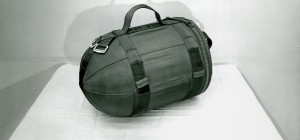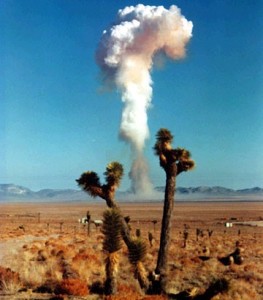“Flying through enemy airspace, operating covertly behind the lines, sneaking up on hostile forces with a nuclear weapon, and waiting uncomfortably close to the bomb before it exploded — the missions were nothing short of preposterous.” — Foreign Affairs magazine
 Throughout the Cold War, the U.S. and NATO were heavily outnumbered by Warsaw Pact forces in weaponry and manpower, so our plans for defending Western European in the event of a Soviet invasion always called for use of nuclear weapons. That’s why the United States never renounced “first use” of nukes — we wouldn’t be able to deter a Soviet invasion, or defend Europe, if we did. And to give U.S. presidents an option between surrender or all-out nuclear exchange, the U.S. military developed low-yielding “tactical” or so-called “battlefield” nuclear weapons. The smallest of these weapons, weighing just 58 lbs., could be carried in a 90-lb. backpack by a Special Forces soldier jumping from an airplane, and was useful for a variety of purposes described in this article. And there were a lot of practical problems involved with its deployment and use, also described in the article.
Throughout the Cold War, the U.S. and NATO were heavily outnumbered by Warsaw Pact forces in weaponry and manpower, so our plans for defending Western European in the event of a Soviet invasion always called for use of nuclear weapons. That’s why the United States never renounced “first use” of nukes — we wouldn’t be able to deter a Soviet invasion, or defend Europe, if we did. And to give U.S. presidents an option between surrender or all-out nuclear exchange, the U.S. military developed low-yielding “tactical” or so-called “battlefield” nuclear weapons. The smallest of these weapons, weighing just 58 lbs., could be carried in a 90-lb. backpack by a Special Forces soldier jumping from an airplane, and was useful for a variety of purposes described in this article. And there were a lot of practical problems involved with its deployment and use, also described in the article.
 The tiny A-bomb was powerful enough to take out a sports stadium or even a small city. The U.S. arsenal had these things by the late 1960s. It goes without saying more thought went into designing them than the implications of using them. Fortunately for us, they were never used, but this is the sort of weapon terrorists would love to get their hands on — we’re not the only country that made them. The Soviets had them, too, and the Israelis are believed to have them. Who knows where all the ex-Soviet nuclear weapons are now, especially the small ones?
The tiny A-bomb was powerful enough to take out a sports stadium or even a small city. The U.S. arsenal had these things by the late 1960s. It goes without saying more thought went into designing them than the implications of using them. Fortunately for us, they were never used, but this is the sort of weapon terrorists would love to get their hands on — we’re not the only country that made them. The Soviets had them, too, and the Israelis are believed to have them. Who knows where all the ex-Soviet nuclear weapons are now, especially the small ones?
Photos: Atomic demolition in a duffle (above), and detonating in a Nevada test (below)